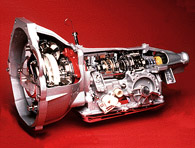
Australian six-cylinder family cars
1948
vehicles of innovation
A family-sized six-cylinder car called the Australian Six was made in Sydney from 1919 to 1930. More than 900 were sold, including some to New Zealand ? Australia?s first car exports. Based on a US design, the car originally used mostly imported parts. Some features were redesigned for local conditions, and the necessary parts were made in Australia; the level of ?local content? eventually reached 60%.
Six-cylinder family cars have been made by several manufacturers in Australia since then and have sold very well. Governments have imposed tariffs to reduce competition from imports and have given companies financial incentives to set up and remain in the country. This is because the car industry provides many jobs and has a large influence on the economy and the balance of trade. Local manufacture also stimulates local innovation in materials and components.
Ford and Holden began assembling cars in Australia in the 1920s, making the bodies themselves and sourcing some other parts locally. They built cars to overseas designs, with imported engines and chassis. After World War 2, the government wanted them to increase local content and employ returned servicemen. To do this, Ford requested a high level of tariff protection; Holden made no such request and won the right to develop the first ?Australian-made? car.
The first Holden, a family six, was made in 1948, and the first Australian Ford Falcon was made in 1960. Both were based on US designs. Holdens dominated the market until Falcons outsold them in 1977. The two competed for top spot for the rest of the century, easily outselling other brands and types of car.
A series of innovations improved both cars and helped them compete against imports. Most of these innovations were sourced from overseas, but Australian engineers and designers made important contributions. Significant Australian innovations included Bishop steering, stronger steel developed by BHP, and a programmable gearbox developed by BTR. The gearbox was developed to Ford?s specifications and became a successful export; it is a good example of how car making stimulates the economy.
By the end of the century, about 6 million Holdens and 3 million Falcons had been made, over 80% of which were family sixes. Australia was exporting engines, other car parts, related engineering services, and tens of thousands of six-cylinder cars each year, cars that are big, durable, relatively safe and affordable, and suitable for both business and family use.
Who Did It?
Key Organisations
Holden: design and manufacture
Ford: design and manufacture
Key People
Laurence Hartnett: led project at Holden
Ben Chifley: Prime Minister, championed project
Charles Smith: led introduction of Falcon
Further Reading
Australia?s own: the history of Holden
S Birney
Golden Press, Sydney, 1985
A history of the Ford Motor Company in Australia
G Easdown
Golden Press, Sydney, 1987
Links
Holden
history
Holden
enthusiast's page
Ford Australia
official website
Falcon enthusiast's
page includes history
Valiants in Australia
Economic
analysis of the Australian car industry
Related Innovations
The Ute
Bishop steering systems
Powerhouse Museum Objects
Australian Six Automobile, 1923
AU Ford Fairmont Ghia automobile
|










